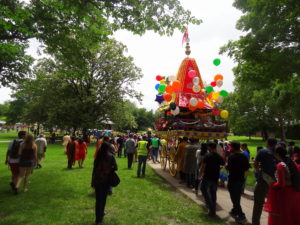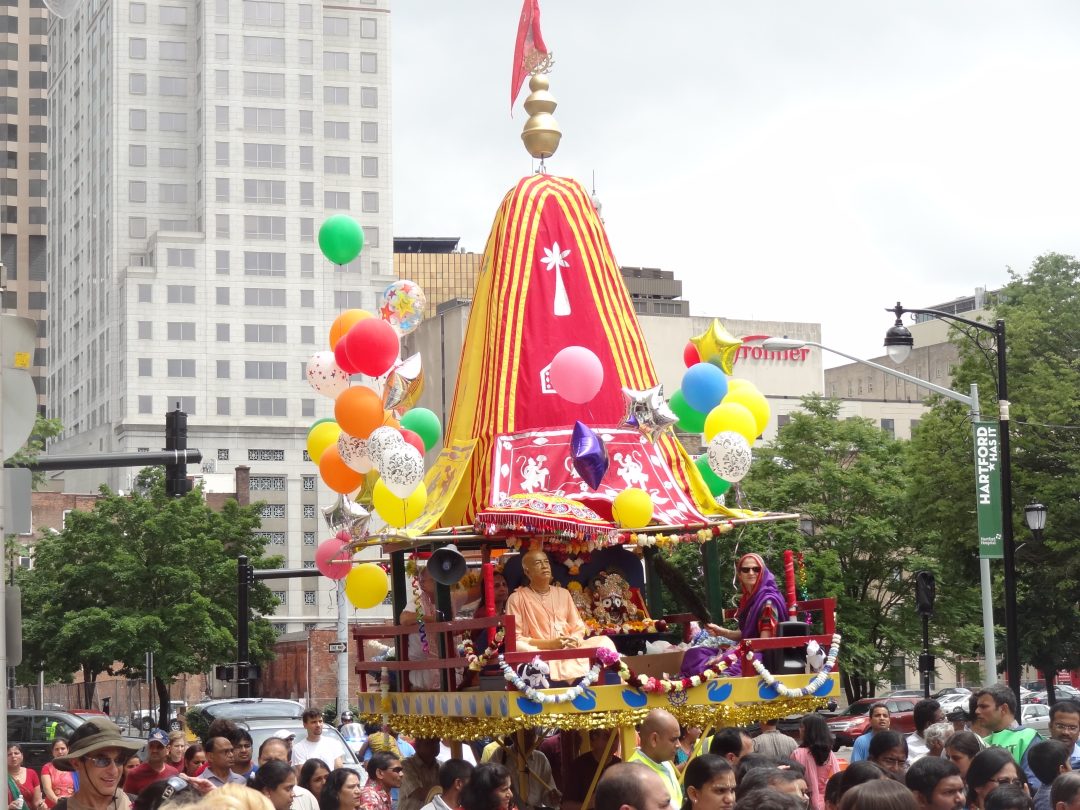The festival is known by several names, each of which highlights the various signs associated with the festival. As the festival is centered around the rath (chariot) journey of the Lord Jagannath and his siblings, it is most popularly referred to as the ‘Rath Yatra’. It is a nine-day annual journey of the Gods, hence ‘Navadina Jatra’ (‘Nava’ for nine, ‘deena’ for days and ‘Jatra’ being the local lingo for the journey). Lord Jagannath, also represents Lord Krishna, who is one of the prime ten reincarnations of Lord Vishnu, or Dus Avatar. So this festival assumes the name of ‘Dusavatar Jatra’ too. ‘Gundicha Jatra’ refers to the Gundicha temple visit undertaken during this annual journey of the Gods.
Rath Yatra (Chariot festival)
The Rath Yatra commemorates the annual visit of Lord Jagannath to the Gundicha temple 2 km away, together with his siblings, brother Balaram and sister, Subhadra. The deities of the Gods Jagannath, Subhadra, and Balaram, preside in the famous temple of Jagannath in the seaside town of Puri.
The festival is celebrated every year on the second day of the waxing moon, falling in the month of June-July. The three presiding deities of the main temple of Jagannath, together with the Sudarshan Chakra (celestial wheel of the Lord), are taken out in three individual raths (royal chariots) in an elaborate ritual, to the accompaniment of chants. The chariot of Lord Jagannath is the largest and most ornately decorated, known as Nandighosh. The other two are Taladhwaja (chariot of Lord Balaram) and Dwarpadalana (chariot of Goddess Subhadra). The three chariots are then drawn by ropes along the Bada Danda avenue to the Gundicha temple. Devotees vie with each other to pull on the ropes of the holy chariot. For it is believed that the one who gets the chance to draw the rope or even touch it, has the blessings of the Lord himself, with all his sins washed away.
 Even the King of Puri, and his heirs, participate in the festival, sweeping the path of the chariots in a holy ritual.
Even the King of Puri, and his heirs, participate in the festival, sweeping the path of the chariots in a holy ritual.
On the way, the chariots stop by Mausima temple, their aunt’s abode, where they feast on Poda Pitha, a favorite of Lord Jagannath, who is believed to be a foodie.
The construction of the raths itself starts on the auspicious day of Akshay Tritya, or Akha Teej, the third day of the waxing moon in the month of May. This coincides with the Chandan Jatra, the Sandalwood festival and the beginning of another harvest season. The chariots are built to specifics and have been a part of the chariot festival since time immemorial.
Significance
Lord Jagannath is identified with lord Krishna, in the form of Pitambara, the one who is adorned in golden yellow robes.
As laid down in the Skanda Purana, a glimpse of Lord Jagannath as he undertakes his annual pilgrimage is considered sacred and auspicious. A touch of the chariot, a touch of the ropes, is enough for penance, for attaining moksh. Such is the piety of the chariots themselves. Those who are fortunate to get close to the deity of Lord Jagannath at Gundicha temple are believed to have received mukti (freedom) from all his sins on earth.
Worldwide celebrations
The Rath Yatra festival though originating from the temple of Puri, where the Lord Jagannath presides, has been replicated in cities and venues across the world. For it is believed that Lord Jagannath is the Lord of the Universe. The ISKCON Hare Krishna movement is particular has started this annual chariot parade in over 100 cities worldwide, wherever the Lord resides in the temples of ISKCON.






